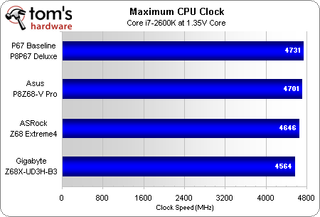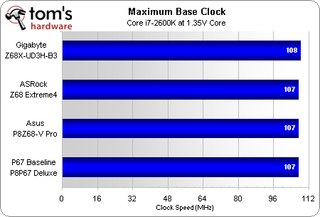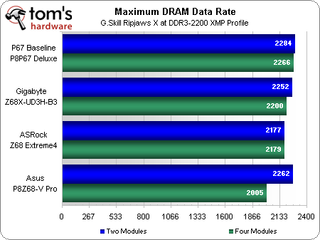Z68 Express Roundup: Three Motherboards Do Battle Around $200
Intel reserved its most feature-rich LGA 1155 platform for (or four?) months past the launch of its Sandy Bridge-based processors, but was it worth the wait? We compare three upper-mainstream Z68 examples to a top-quality P67 predecessor to find out.
Overclocking Results
| BIOS Frequency and Voltage settings (for overclocking) | |||
|---|---|---|---|
| Row 0 - Cell 0 | ASRock Z68 Extreme4 | Asus P8Z68-V Pro | Gigabyte Z68X-UD3H-B3 |
| CPU Base Clock | 95-110 MHz (0.1 MHz) | 80-300 MHz (0.1MHz) | 80-200 MHz (0.1MHz) |
| CPU Multiplier | Up to 60x | Up to 59x | Up to 59x |
| DRAM Data Rates | 1066-2133 (266.6 MHz) | 800-2400 (266.6 MHz) | 800-2133 (266.6 MHz) |
| CPU Vcore | 0.60-1.70 V (5 mV) | 0.80-1.99 V (5 mV) | 0.75-1.70 V (5 mV) |
| VTT Voltage | 0.66-1.87 V (13 mV) | 0.80-1.70 V (6.25 mV) | 0.90-1.53 V (5 mV) |
| PCH Voltage | 0.78-1.65 V (9 mV) | 0.80-1.70 V (10 mV) | Not Adjustable |
| DRAM Voltage | 1.20-1.80 V (15 mV) | 1.20-2.20 V (6.25 mV) | 0.87-2.13 V (5 mV) |
| CAS Latency | 5-15 Cycles | 3-15 Cycles | 5-15 Cycles |
| tRCD | 4-15 Cycles | 4-15 Cycles | 1-15 Cycles |
| tRP | 4-15 Cycles | 4-15 Cycles | 1-15 Cycles |
| tRAS | 10-40 Cycles | 4-40 Cycles | 1-40 Cycles |
Does enabling our Core i7-2600K’s integrated GPU severely limit its overclocking capability? We wanted to find out.

While the P67 motherboard leads slightly in overclocking, it also comes from a higher-end product line. The difference of a few MHz between the two Asus motherboards is less than the difference we’ve seen between two identical motherboards pulled from the production line at different times.
The only motherboard to suffer under our CPU overclocking test, Gigabyte’s Z68X-UD3H also has the least-elaborate voltage regulator. That’s appropriate for the lowest-priced board in the roundup.

Gigabyte does achieve a higher base clock, in spite of its simpler voltage regulator. That could be important for overclocking “locked” processors, though high base clocks have been known to slowly damage LGA 1155-based chipsets.

The P67 platform leads in DRAM overclocking, and that could be due to the integrated GPU being enabled on its Z68 competitors. Then again, Asus is often good at memory overclocking, and the P8Z68-V Pro might just be an exception to that rule.
In fact, the reason the P8Z68-V Pro has a comparatively low four-module overclock is because the motherboard kept shutting off when we pushed those modules. This appeared to be due to overcurrent protection, which makes sense because this Z68 motherboard has a “one level lower” voltage regulator than its P67 sibling.
Stay on the Cutting Edge
Join the experts who read Tom's Hardware for the inside track on enthusiast PC tech news — and have for over 25 years. We'll send breaking news and in-depth reviews of CPUs, GPUs, AI, maker hardware and more straight to your inbox.
-
Crashman user 18ASrock comes with 4 eSATA cables?KisakukuThe first UEFI screenshots for ASRock and Asus are switched.Fixed, thanks!Reply -
evga_fan ->ThomasReply
"Gigabyte’s Quick Boost application sets our processor at 200, 400, or 700 MHz beyond its rated frequency."
Just so you know. Anyways, keep up the good work!
Cheers -
crisan_tiberiu so, basicaly there is no difference in performance between theese boards as i can see.Reply -
hmm .. was thinking of getting an Asus P8Z68-V Pro .. not so sure now knowing that the other boards offer the same performance and are both cheaper.Reply
-
Olle P One additional feature of the ASRock card that isn't mentioned is its set of holes matching a socket 775 cooler. That feature was the main reason I ordered one of these cards three days ago, since I won't have to spend money on a new CPU cooler.Reply -
crisan_tiberiu Olle POne additional feature of the ASRock card that isn't mentioned is its set of holes matching a socket 775 cooler. That feature was the main reason I ordered one of these cards three days ago, since I won't have to spend money on a new CPU cooler.Reply
ermm thats pro, since i have a socket 775 core 2 duo atm. Any other motherboards out there that suport this?? i would love to know

